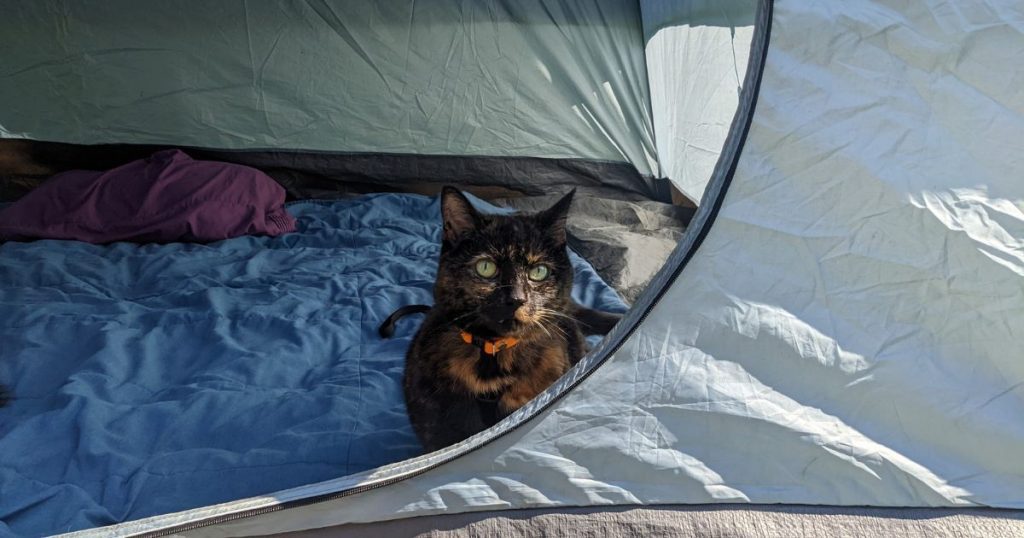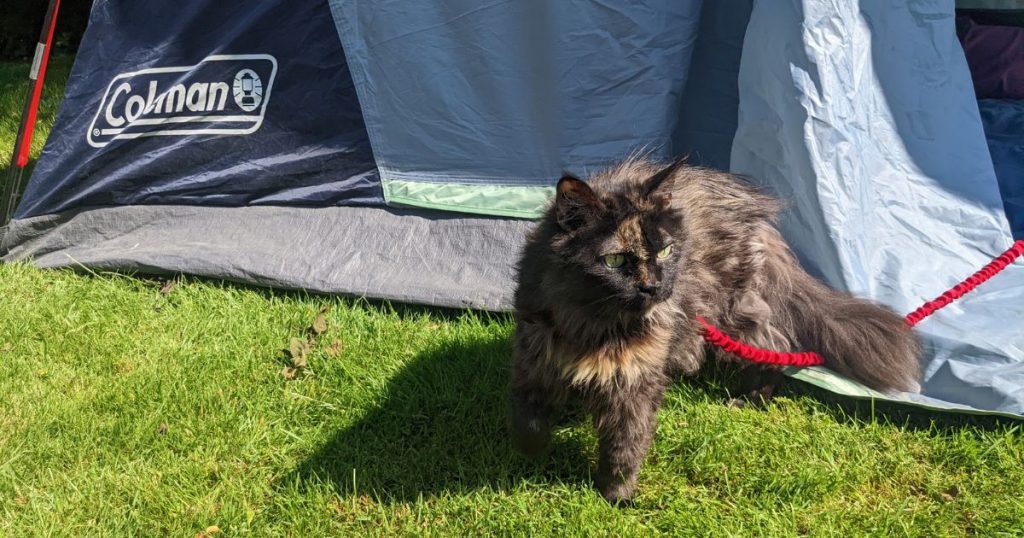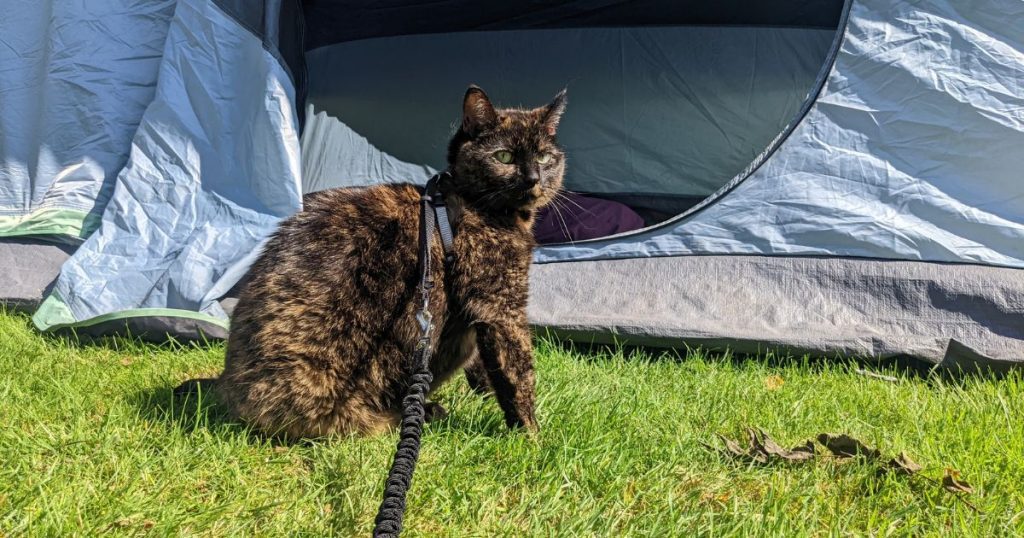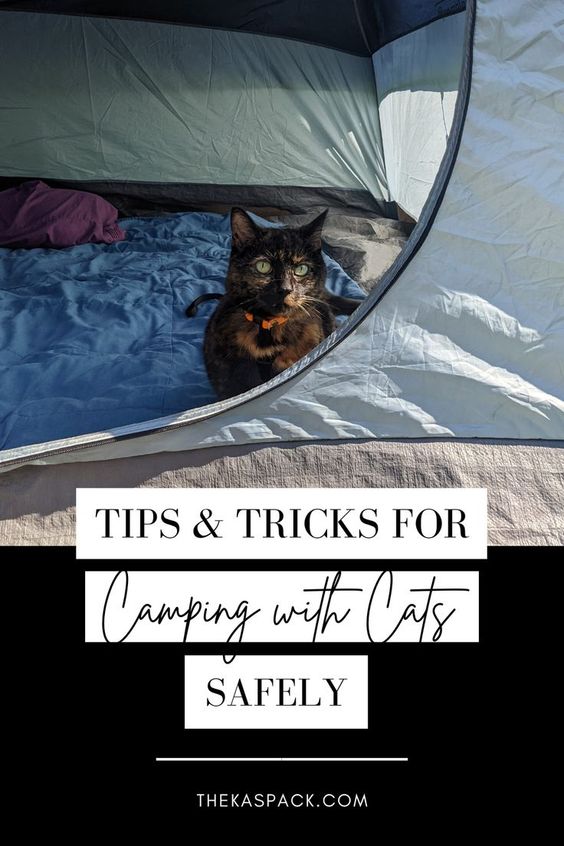The Ultimate Guide to Tent Camping with Cats
A growing number of cat lovers are bringing their furry friends along on their outdoor adventures.
But can a cat safely and comfortably join in on a tent camping getaway?
Whether you prefer glamping with all the amenities or backpacking into a more rustic site in the wilderness, your cat can join in on the adventures.
This guide answers the most common questions we hear about tent camping with cats to help you get started.
Let’s get started!

This post contains affiliate links, which means if you click and buy, we will make a commission (at no cost to you). See my full disclosure policy for more details.
Why Would I Take My Cat Camping?
If you’ve never brought your cat camping before, you may be wondering – why start now? What benefit is there in bringing your cat along?
Spending time outdoors is an excellent mental and physical enrichment for many cats.
It allows them to enjoy new scents, smells, sights, and experiences. For example, our girl Pippen loves birdwatching with me in the hammock.
Of course, I’m not suggesting just letting your cat roam free. Outdoor cats face many serious risks, drastically cutting their expected lifespan.
When camping and hiking with our cats, they are contained and supervised, allowing them to enjoy and explore the outdoors safely.
Travelling with your cat is a great way to strengthen your relationship and spend quality time together.
Plus, it alleviates one of the biggest travel concerns cat parents share – what to do with your cat when you’re not home.
As long as your cat enjoys the outdoor adventure life (more on that next), it’s a win-win situation for everyone involved!
Not Every Cat is a Camping Cat
While we would love to say that every cat can be taught to camp, the hard truth is that not every cat is a camping cat. Some cats are happier with the comforts of home.
As you introduce the concept of camping, your cat will communicate their feelings and reactions in various ways, such as through body language or changes in behaviour.
As a cat parent, it’s your job to listen to what your cat is trying to tell you.
Just as some people are uncomfortable with sleeping outdoors, the same can be said for cats.
Forcing the camping experience on a cat that isn’t comfortable will ruin the experience not only for your cat but also for you.
If you notice that your cat is unhappy with camping, the best thing you can do is find alternate arrangements.
Consider having your cat spend time with a trusted friend or family member, or organize a stay at a nice pet hotel. This will allow you both to enjoy this vacation time in your own way.
Alternatively, you can consider hiring a pet sitter by asking cat-loving friends for referrals or checking out a site like Rover. But be sure to meet and get to know your potential sitter first – after all, you don’t want to leave your furry family member with anyone you don’t trust completely!
Can You Camp in a Tent with a Cat?
Have you ever considered taking your cat camping but dismissed the idea because you plan on tent camping? If so, you’re not alone.
A common misconception is that cats can’t camp safely in a tent. Don’t let this discourage you from including your best friend in your travels.
While there are some unique concerns to address when camping with cats, it can be done.
There are many adventure cats embracing their love of the outdoors with their human family members – even happily spending the night in a tent.
With the right gear, preparation, and training, your cat can learn to love tent camping as much as our two do.
How Can I Get My Cat Used to a Tent?
With two professional camping cats (or, at least, they believe they are), we have shown firsthand how much fun tent camping can be for cats.
But what’s our secret to success? How did we get started?
One of the most important things you can do before camping with a cat is introduce them to your tent at home.
This will allow them to get used to the tent in the safety of a familiar space, such as your backyard or living room.
Set the tent up and give your cat time to check it out. This could involve walking around it, eyeing it from a distance, sniffing at it, and exploring inside.
You can begin to create a positive association with the tent by feeding your cat in it or placing some of their favourite toys inside.
Another possibility is to get comfortable inside the tent with your cat’s favourite treats, giving them something special every time they join you.
The goal is to convince them that spending time in the tent means good things are coming their way.
As you see your cat becoming more comfortable around the tent, try spending a night inside.
Set up your tent with everything your cat needs during your travels, including a litter box, food and water, and their favourite bed from home.
If things don’t go well the first night and they become anxious or restless, don’t be afraid to end your ‘trip’ early. One of the biggest perks of camping at home is that you don’t have far to go when you decide that the camping adventure is over.
It may take multiple attempts to work up to spending an entire night, and that’s okay!
Note any sources of stress or anxiety for your cat. This will help you make the experience more comfortable for everyone involved.
For example, some cats feel safer and more content in an enclosed pet playpen space.
No one ‘right way’ to enjoy tent camping with cats exists. Don’t be afraid to experiment, try new things, and find what works best for you and your feline friend.

Where Do You Put a Cat Litter Box in a Tent?
I mentioned including a litter box in your setup. However, this raises an important question for many cat parents…
When taking a cat tent camping, where can you put a litter box to ensure it is available to them when needed?
Luckily, there are some great litter box options to consider. This includes collapsible litter boxes for easy travel or, if your cat prefers, covered litter boxes to offer some added privacy.
We have found that the best place to put the litter box in the tent is to tuck it in a corner. Another option is to use the space under the bed if we’re camping with cot beds instead of a standard air mattress.
You will want to find a cat litter that effectively controls odours in that small space (especially for a box under your bed).
If possible, stick to a litter with minimal or no dust during use. If you are concerned about the smell, try a litter deodorizer — but avoid anything scented.
Scented products are known to attract wildlife, creating a safety concern.
Speaking of safety, clean your cat’s litterbox as soon as possible after use. Not only will this help control the smell, but it’s also an essential step in terms of safety when camping in bear country.
Pro tip: Use dog poop bags to easily clean the litter box and deal with your cat’s business.
Can I Wild Camp with a Cat?
Yes! Wild camping or backcountry camping with a cat is possible. However, a few additional considerations must be made to make the trip safe and enjoyable for everyone involved.
First, consider how you are getting to the site and where your cat fits in that plan.
Are you hiking in? If your cat gets tired, what are your plans for helping to carry them – especially if you already have your gear on your back?
We have trained Pippen to ride on top of our hiking pack when she needs a break. That does take training – so don’t wait until the day of your trip to try it for the first time.
Are you canoeing or kayaking to your site? Is your cat familiar with and comfortable with being on the water? What is your plan for during a portage?
Most of the usual safety rules apply when you arrive at your campsite. For example, your cat’s food and treats must be stored in bear canisters or hung with yours.
The one significant difference to consider is the litter box.
Some adventure cat parents teach their cats to go outdoors, much like a dog – which means all you would need is poop bags to pack out their waste.
If your cat insists on having a litter box, you will need to choose a travel-friendly option that doesn’t take up too much space. Lighter weight litters can also help keep the weight down.
Keep the box clean, removing waste anytime they use the box to avoid attracting predators.
How to Prepare for a Cat-Friendly Camping Trip
A safe and enjoyable camping trip with your cat starts with careful planning. Here are a few things you can do before your trip to set everyone up for success:
Schedule a Pre-Camping Visit with Your Veterinarian
Before heading out on any adventures with your cat, make an appointment for a check-up with your veterinarian.
This is a chance to ensure there are no health concerns with your cat travelling outdoors. It’s also the perfect time to make sure that your cat’s vaccinations are up to date.
Double-Check Identification
Take a moment to double-check the information on your cat’s ID tags.
You should check that the contact information is current and the tags are still legible. Over time, they can become worn down to the point that the information is hard to read.
Finally, if your cat is microchipped, check the contact details associated with it to ensure they are also up to date.

Prepare for the Weather Conditions
Pay careful attention to the weather forecast in the days leading up to your trip.
Consider this when packing your gear.
If the weather is incredibly hot, bring some gear to help keep your cat’s temperature down, like a cooling bed.
On the other hand, if you’re planning a trip on a cool fall day, you may want to include a heating pad or extra blankets so that your cat can sleep comfortably at night.
Be Proactive with Fleas and Ticks
Spending time outdoors will significantly increase your cat’s risk of fleas and ticks. But there are reliable options to keep these unwanted hitchhikers at bay.
Not only do fleas and ticks bite, making for an uncomfortable situation, but they are also carriers of some serious diseases.
Before tent camping with our cats, we always take the time to apply a flea preventative.
Tick preventative medications used by dogs are toxic to cats, but there are some natural options you may wish to consider.
Apple cider vinegar, for example, is a natural tick repellent that we often use. Mix up a 50/50 mixture and either spray it on your cat or (if they dislike being sprayed) wet a cloth and wipe it over their fur before spending time outdoors.
The Tickless Mini is a smaller version of the original Tickless Ultrasonic Tick and Flea Repellent, making it the perfect size for a cat’s collar.
Tips & Tricks for Tent Camping with Cats
Here are some important things to consider during your trip, ranging from the setup of your campsite to potential risks you may encounter:
Be Mindful of Your Cat’s Normal Schedule
One of the most overlooked tips for taking your cat camping relates to your daily routine.
To help reduce any stress your cat may experience in a new space, try to stick to the usual schedule that your cat is used to at home.
This includes simple things like feeding them at the same time and cuddling them before bed if that’s part of your regular nighttime routine.
Set Up the Tent Like Home
Consider setting the tent up like home to make it appear more familiar to your cat and help them adjust.
This could mean keeping their food and water dishes on the mat they use at home or placing their bed in the same location near your bed.
Alternatively, introduce their playpen at home so they can get used to everything and replicate that when setting it up at camp.
Never Leave Your Cat Unsupervised
Far too many predators and risks could endanger your cat when camping to let them be unsupervised.
You should make a point of always keeping your cat close by where you can keep a watchful eye on them.
Given their smaller size, cats are an easy target for predators like hawks and coyotes. They are also master escape artists!
Bring your cat along for short trips to the bathroom or shower. When you’re in the stall, ensure they are fully contained and out of sight of local wildlife.
If you’re camping with a friend or family, have them watch over your cat at the site until you return.
For added security and to prevent your cat from sneaking out, place them inside a playpen or carrier when inside your tent at night.
Be Cautious Around the Campfire
What is camping without a campfire? True! However, as cat parents, we must be careful with our cats around the crackling fire.
The campfire is often a new experience, and their curiosity can get the best of them.
Keep an eye on your cat anytime they are near a fire, or keep them contained in a playpen or outdoor enclosure to keep them safe.
Avoid Crowded Trails or Areas
Choose your campsite, hiking trails, and any other planned activities carefully to avoid the more populated and busy areas.
Not only are these crowded spaces louder, which can be overwhelming for your cat, but there is a higher risk of encountering unleashed dogs, high-energy children, and other situations they may find uncomfortable.
Instead, choose a campsite away from high-traffic areas like playgrounds and beaches. If possible, find a more private site with a buffer of vegetation between you and your nearby campers.
If you are hiking with your cat and worried about how many people you may encounter, a cat backpack is always a good investment.
Not only does this offer a safe place to contain your cat if needed, but it’s also a comfortable place for them to relax when their little legs need a break.
Provide Your Cat with a Place to Escape To
Space is slightly limited when tent camping with cats. This means that you must be strategic about fitting everything you and your cat will require.
Luckily, a place to escape to doesn’t have to be large or elaborate. It just needs to be a safe space for your cat to retreat to when they want to be left alone.
Bringing a covered cat bed is one easy way to incorporate that in the tent.
Place it in a quiet corner of the tent away from the door. If you have children, make sure they know that when your cat is in their bed, they don’t want to be disturbed.

Must-Have Cat Camping Gear
Your cat’s camping gear is a valuable tool in ensuring everyone can enjoy a safe trip.
Of course, the items alone won’t solve every potential challenge. But the right gear combined with training, supervision, and careful planning will put you on the right path!
Here are a few of the items we consider to be a “must-have” when taking Pippen and Jinx on our adventures:
For Your Cat
The first category I want to address is gear specifically for cats.
Selecting the best harness for your cat is essential. This is the most important item to keep them safe during your travels.
Each cat is unique, and there’s no ‘one-size-fits-all’ solution for harnesses. The key is to find the harness that fits your cat best, keeping them both comfortable and secure.
Our two cats wear two different harnesses, as that’s what works best for them.
Harnesses that we recommend considering when searching for the best fit for your cat include:
- RC Pet Products Adventure Kitty Harness
- Catit Nylon Adjustable Cat Harness
- PetSafe Come with Me Kitty Harness (this is what Jinx wears)
- OutdoorBengal Houdini Escape Proof Cat Harness
- Cat School Secure Cat Vest Harness
- Sleepypod Martingale Cat Harness
I also highly recommend Biothane leashes as they are easy to clean. We love the Kylo Leash from KittyCatGo. Use the discount code ‘THEKASPACK10’ for 10% off your order.
Finally, we never go camping without our Nite Ize PetLit LED Collar Light so we can see them easily at night.
In the Tent
When setting up the tent, we want to create a comfortable space for our cats to play quietly or sleep at night. Quietly is, of course, an important word to remember here!
When car camping, we keep the cats in a PawHut Fabric Playpen at night. This portable playpen easily folds up for travel and prevents them from bolting out the door if we go to the bathroom at night.
Inside their pen, we include the following items:
- A couple of small whisker-friendly stainless steel cat bowls (food and water)
- Mora Pets Waterproof Cat Bed (with a self-heating pad or cooling mat, depending on the time of year we’re camping)
- HiCaptain Portable Litter Box for Cats
- Some quiet toy options they can play with, such as little toy mice or plastic springs
Backcountry camping is a little more challenging due to the limitations on gear we can carry into the campsite.
We don’t bring a playpen or enclosure. Instead, the cats stay on leash the entire time they are in the tent.
For a litter box, we prefer the OutdoorBengal Travel Litter Box for Cats due to its impressively small and lightweight size, which is great for travel.
At the Campsite
When setting up the campsite, you want to create a safe, contained place for your cat to hang out during the day.
This could mean keeping the cat on a tie-out with their harness for some. However, there is no such thing as a cat harness that is actually “escape-proof,” so I don’t recommend trusting a harness unless you are right there holding the leash.
We use a couple of different enclosures, depending on the campsite and what we choose to pack, including:
- Kittywalk Penthouse with Resting Platforms plus the added Kittywalk Outdoor Net Cat Enclosure off one side
- X-Zone Pet Foldable Metal Pet Playpen with Cover
This space is then set up with several items we bring over from their indoor pen, including the bed, food and water dishes, litter box, and toys.
Most importantly, don’t forget to pack a pet-friendly first aid kit!

Do you have experience tent camping with cats? If so, we would love to hear about your adventures and any advice for other cat-friendly campers in the comments.
